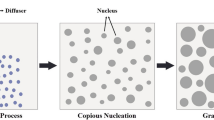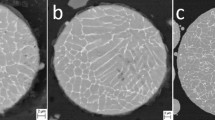This article is devoted to establishing regularities of the influence of gas atomization process parameters of aluminum alloy VAS1 melts on the grain size composition of the resulting powder. Seventeen iterations of atomization of melts of VAS1 alloy billets with a varied content of alloying elements, and with different operating parameters of the process are carried out. An assessment is made of the relationship between characteristics of the powder particle size distribution by weight fractions (percentage of the fraction 10–63 μm, median powder particle size, excess and asymmetry coefficients). Correlation analysis of the influence of atomization process parameters on the value of the median particle diameter, as well as the influence of controlled parameters on melt mass flow rate is conducted. The Kishidaka equation is tested to predict the median particle diameter in the process of VAS1 alloy gas atomization. Some of the powders obtained are subjected to screening in order to obtain fractions of 10–63, 30–80 and 63–100 microns to study their technological properties.







Similar content being viewed by others
References
S. A. Oglezneva, A. A. Smetkin, V. I. Mitin, and K. V. Kalinin, “Effect of melt atomization parameters on production properties of 12Kh18N10T grade powder,” Mashin. Metaerialoved., No. 4, 122–137 (2017).
A. M. Volkov, A. A. Shestakova, and M. M. Bakradze, “Comparison of granules obtained by gas atomization and centrifugal atomisation of cast billets from the point of view of using them for preparing GTE disks made of heat-resistant nickel alloys,” Trudy VIAM Élektron. Nauch. Tekn. Zh., No. 11, Art. 02 (2018); URL: http://www.viam-works.ru (access date 20.04.2022); https://doi.org/10.18577/2307-6046-20180-11-12-19.
E. N. Kablov, A. G. Evgenov, M. M. Bakradze, S. V. Nerush, and O. A. Krupnina, “Materials of a new generation and digital additive technology for producing FGUP VIAM components. Part. 1. Materials and synthesis technology, “Élektrometallurgiya, No. 1, 2–12 (2022).
A. E. Knyazev, S. V. Nerush, M. I. Alishin, and I. S. Kuko, “Study of technological properties of metal powder composite titanium alloys VT6 and VT20 prepared by induction melting and gas atomization,” Trudy VIAM Élektron. Nauch. Tekn. Zh., No. 11, Art. 06 (2017); URL: http://www.viam-works.ru (access date 20.04.2022); https://doi.org/10.18577/2307-6046-2017-0-11-6-6.
E. N. Kablov, A. G. Evgenov, O. G. Ospennikova, B. I. Semenov, A. B. Semenov, and V. A. Korolev, “Metal powder composite heat-resistant alloy ÉP648 produced by FGUP VIAM GNTs RF in technologies for selective laser melting, laser gas powder melting, and high speed casting of polymers filled with metal powders,” Izv. Vuzov. Mashinostroenie,, No. 9(678), 62–80 (2016).
M. I. Alishin and A. E. Knyazev, “Production of metal powder compositions of high purity titanium alloys by induction gas atomization for additive technologies,” Trudy VIAM Élektron. Nauch. Tekhn. Zh., No. 11, Art. 05 (2017); URL: http://www.viam-works.ru (access date 20.04.2022); https://doi.org/10.18577/2307-6046-20170-11-5-5.
I. V. Yatsyuk, N. I. Artemenko, O. N. Doronin, and S. V. Nerush, “Use of gas atomization technology for preparing high quality metal powder composites for application of atmosphere-plasma coatings,” Tr. VIAM: Elektron. Nauch.-Tekhn. Zh., No. 2, Art. 01 (2020); URL: http://www.viam-works.ru (access date 20.04.2022); https://doi.org/10.18577/2307-6046-2020-0-2-3-9.
M. Tsirlis and N. Michailidis, “Low-pressure gas atomization of aluminum through a Venturi nozzle,” Advanced Powder Technology, No. 31, 1720–1727 (2020); 10.1016/ 2020.02.011.
E. Urionabarrenetxea, A. Avello, A. Rivas, and J. M. Martín, “Experimental study of the influence of operational and geometric variables on the powders produced by close-coupled gas atomization,” Materials and Design, No. 199, 1264–1275 (2021); https://doi.org/10.1016/2020.109441.
O. Hong-wu, C. Xin, and H. Bai-yun, “Influence of melt superheat on breakup process of close-coupled gas atomization,” Trans. of Nonferrous Metals Society of China, No. 17, 967–973 (2007).
D. Goudar, V. C. Srivastava, and G. B. Rudrakshi, “Effect of atomization parameters on size and morphology of Al-17Si alloy powder produced by free fall atomizer,” Engineering J., No. 21, 155–168 (2017); https://doi.org/10.4186/ej.2017.21.1.155.
E. N. Kablov, A. G. Evgenov, I. S. Mazalov, S. V. Shurtakov, D. V. Zaitsev, and S. M. Prager, “Structure and characteristics of EP648 and VZh159 alloys synthesized by selective laser melting after simulated annealing,” Inorganic Materials: Applied Research, No. 12, 117–124 (2021).
A. A. Buyakina, A. E. Knyazev, A. M. Volkov, and I. S. Kuko, “Study of gas atomization parameters of heat-resistant nickel alloy for gas turbine engine disks,” Zagotovit. Proizvod. Mashin., 15, No. 9, 420–425 (2017).
V. M. Boiko and S. V. Poplavskii, “Features of water droplet dynamics in a stream ahead of an impact wave,” Vest. NGU, No. 2, 28–33 (2008).
H-w. Ouyang, X. Chen, and B-y. Huang, “Influence of melt superheat on breakup process of close-coupled gas atomization,” Trans. of Nonferrous Metals Society of China, No. 17, 967–973 (2007).
P. A. Lykov, R. M. Baitimerov, E. V. Safonov, and O. A. Shul’ts, “Modeling the process of melt sputtering within a gas stream,” Vest. YuUrGu, No. 2, 148–154 (2013).
N. N. Anenko, V. M. Boiko, and S. V. Poplavskii, “Physical model of droplet breakdown in a shock wave by a shear mechanism,” Coll. Internat. Conf. “Contemporary Problem of Applied Mathematics and Mechanics: Theory, Experiment, and Practice, Devoted to 90th Anniversary of the Birth of Academician N. N. Yatsenkov”, Inst. Theoret. and Applied Mechanics named after S. A. Khristianovich, Novosibirsk (2011).
A. I. Rudskoi, Yu. A. Sokolov, and V. N. Kopaev, “Modelling the process of cooling sprayed metal particles within a gas mixture of helium and argon,” Nauch.-Tekhn. Vedomosti Sankt-Pet. Gos. Politekh. Univ., No. 4, 104–115 (2014).
H. Lubanska, “Correlation of spray ring data for gas atomization of liquid metals,” J. Metal., No. 2. P. 45–49 (1970).
H. Kishidaka, “Theory and production of atomized iron powder,” in: Proc. of the Multidisciplinary Meeting on Sintered Metals and Magnetic Materials, Japan Society for Powder and Powder Metallurgy (1973).
Author information
Authors and Affiliations
Corresponding author
Additional information
Translated from Metallurg, Vol. 67, No. 6, pp. 43–52, June, 2023.
Appendix. Values of Median Particle Diameter and Process Calculated Parameters (Gas Velocity and Density in within Primary Crushing Zone, Heating Magnitude, Surface Tension Values, Dynamic Viscosity, Melt Surface Tension Values at Pouring Temperatures, and Also the Ratio of Gas and Melt Weight Consumption)
Appendix. Values of Median Particle Diameter and Process Calculated Parameters (Gas Velocity and Density in within Primary Crushing Zone, Heating Magnitude, Surface Tension Values, Dynamic Viscosity, Melt Surface Tension Values at Pouring Temperatures, and Also the Ratio of Gas and Melt Weight Consumption)
Iteration number | D50 | ug, m/sec | ρg, kg/m3 | ΔT, °C | ρm | μm, | σm | mg/mm |
|---|---|---|---|---|---|---|---|---|
1 | 44 | 32 | 0.858 | 214 | 0.85 | 0.00102 | 2390 | 4.4 |
2 | 68 | 39 | 0.841 | 234 | 0.843 | 0.00099 | 2384 | 3 |
3 | 47 | 46 | 0.827 | 234 | 0.843 | 0.00099 | 2384 | 4.8 |
4 | 46 | 51 | 0.82 | 237 | 0.829 | 0.00093 | 2375 | 3.4 |
5 | 63 | 17 | 0.938 | 212 | 0.838 | 0.00098 | 2383 | 3.3 |
6 | 58 | 35 | 0.852 | 202 | 0.857 | 0.00107 | 2399 | 2.6 |
7 | 43 | 40 | 0.839 | 155 | 0.874 | 0.00118 | 2412 | 4.7 |
8 | 43 | 58 | 0.81 | 142 | 0.85 | 0.00103 | 2390 | 4.3 |
9 | 42 | 47 | 0.827 | 123 | 0.858 | 0.00107 | 2396 | 4.5 |
10 | 38 | 56 | 0.813 | 143 | 0.85 | 0.00103 | 2390 | 5.7 |
11 | 39 | 56 | 0.813 | 141 | 0.85 | 0.00103 | 2390 | 4.1 |
12 | 40 | 54 | 0.815 | 143 | 0.851 | 0.00103 | 2390 | 5.1 |
13 | 41 | 57 | 0.811 | 200 | 0.848 | 0.00102 | 2388 | 5.2 |
14 | 49 | 60 | 0.808 | 197 | 0.85 | 0.00103 | 2388 | 4.4 |
15 | 34 | 57 | 0.811 | 192 | 0.851 | 0.00103 | 2390 | 7.4 |
16 | 65 | 40 | 0.84 | 159 | 0.857 | 0.00106 | 2394 | 2.9 |
17 | 56 | 36 | 0.847 | 170 | 0.866 | 0.0011 | 2392 | 4.1 |
Rights and permissions
Springer Nature or its licensor (e.g. a society or other partner) holds exclusive rights to this article under a publishing agreement with the author(s) or other rightsholder(s); author self-archiving of the accepted manuscript version of this article is solely governed by the terms of such publishing agreement and applicable law.
About this article
Cite this article
Shchetinina, N.D., Antipov, V.V., Speransky, K.A. et al. Investigation of Influence of Gas Atomization Parameters on the Granulometric Composition of Aluminum Alloy Vas1 Powder. Metallurgist 67, 768–781 (2023). https://doi.org/10.1007/s11015-023-01564-7
Received:
Revised:
Accepted:
Published:
Issue Date:
DOI: https://doi.org/10.1007/s11015-023-01564-7




